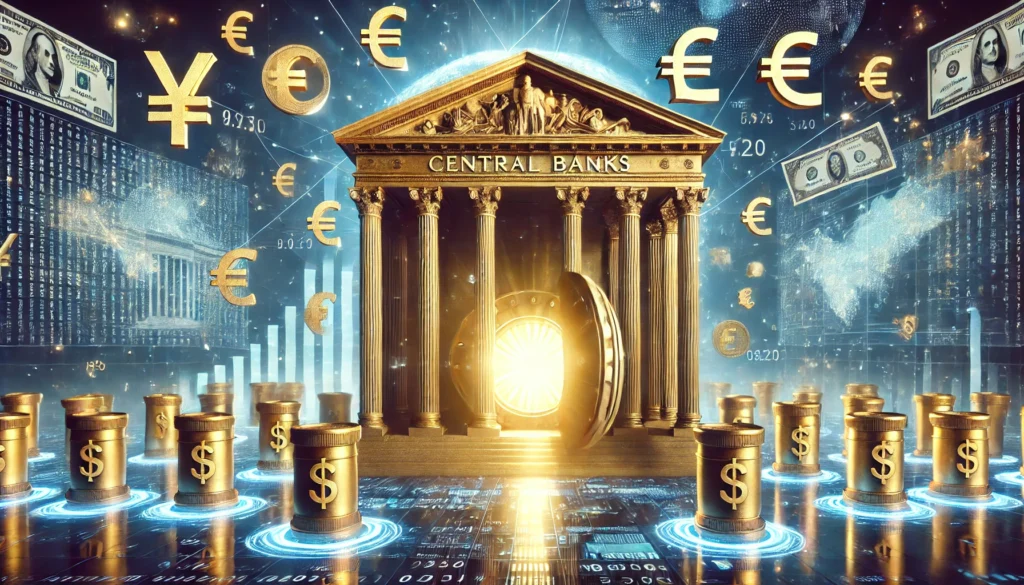
The Central Banks

Introduction
The Central bank is vital in managing national economies by controlling monetary policy, stabilizing inflation, and overseeing financial institutions. Their decisions impact everything from interest rates and currency value to employment and long-term economic growth. This article explores how these banks influence economic stability and ensure financial resilience.
1. What Is a Central Bank?
A. Definition and Functions
- A central bank is an institution responsible for regulating a nation’s currency, money supply, and interest rates.
- Examples include the Federal Reserve (U.S.), European Central Bank (ECB), and Bank of England.
B. Key Responsibilities
- Monetary policy regulation to control inflation and economic growth.
- Issuing currency and managing exchange rates.
- Supervising commercial banks to prevent financial crises.
📌 Source: Federal Reserve – Central Banking Overview
2. How Central Banks Control Inflation and Deflation
A. Inflation Management
- Inflation erodes purchasing power; central banks use interest rate adjustments to manage it.
- Higher interest rates slow inflation by making borrowing more expensive.
B. Avoiding Deflation and Economic Stagnation
- Deflation reduces consumer spending, leading to recessions.
- Central banks lower interest rates and increase money supply to counteract deflation.
📌 Source: IMF – Inflation and Monetary Policy
3. The Role of Central Banks in Financial Crises
A. The Lender of Last Resort
- During economic downturns, central banks provide emergency liquidity to struggling banks.
- Example: The 2008 financial crisis, where the Federal Reserve intervened to stabilize markets.
B. Quantitative Easing (QE)
- QE involves purchasing government bonds to inject liquidity into the economy.
- Used during crises to encourage lending and economic recovery.
📌 Source: World Bank – Central Banks and Crisis Management
4. The Impact of Central Bank Policies on Economic Growth
A. Interest Rate Policies
- Low rates encourage borrowing and investment, boosting economic activity.
- High rates control inflation but can slow growth and job creation.
B. Exchange Rate Stabilization
- Central banks intervene in forex markets to prevent currency fluctuations.
- Stable exchange rates promote international trade and economic confidence.
📌 Source: European Central Bank – Interest Rates and Economic Growth
5. The Debate: Should Central Banks Have More or Less Power?
A. Arguments for Strong Central Banks
- They provide financial stability and prevent economic collapses.
- Independent central banks reduce political interference in economic policy.
B. Criticism of Central Banks
- Some argue central banks manipulate markets and cause economic bubbles.
- Calls for decentralized financial systems, including cryptocurrencies, challenge central banking authority.
📌 Source: Harvard Business Review – The Power of Central Banks
6. The Future of Central Banking
A. Central Bank Digital Currencies (CBDCs)
- Countries like China and the EU are developing state-backed digital currencies.
- CBDCs aim to modernize financial systems and reduce reliance on cash.
B. AI and Automation in Central Banking
- AI-driven financial models are improving economic forecasting and policy decisions.
- Blockchain technology may redefine monetary policies in the future.
📌 Source: Bank for International Settlements – The Future of Central Banking
Conclusion
Central banks play a crucial role in maintaining economic stability through monetary policies, inflation control, and crisis management. As economies evolve, central banks must adapt to new financial challenges, including digital currencies and decentralized finance.
Do you think central banks should have more control over the economy, or should we rely on decentralized financial systems? Share your opinion in the comments!
📌 Additional Resources:
Read Also: The Economic Inflation: All What You Must Know




1 thought on “The Central Bank | The Astonishing Facts You Don’t Know”